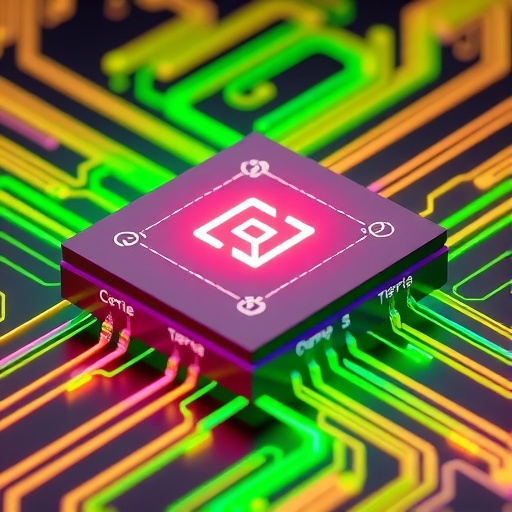In a groundbreaking advancement for quantum technology, researchers at Delft University of Technology have engineered a chip-based device capable of splitting single phonons—quanta of mechanical vibrations that transport information in emerging quantum systems. This innovative device represents a critical step forward in the development of compact, integrated phononic circuits, promising to forge links between disparate quantum platforms and significantly accelerate the advent of scalable quantum computing and secure quantum communication networks.
Quantum information science is increasingly reliant on the ability to transfer quantum states between heterogeneous systems, each specialized for particular tasks such as fast computation or long-term information storage. Phonons, as discrete mechanical excitations, offer a compelling medium for this transfer due to their capacity to interface with various quantum systems on a chip. The research team, led by Simon Gröblacher, recognized the necessity for essential phononic components that could not only generate coherent phonons and route them across chip architectures but also controllably split them—a capability that was previously absent in chip-scale technology.
Published in the journal Optica Quantum, this study introduces and examines a miniature integrated directional coupler specially designed for single phonons. This four-port silicon chip device functions analogously to well-established optical couplers but is optimized to operate using high-frequency mechanical vibrations at cryogenic temperatures. The coupler allows for precise manipulation of phonon pathways through controlled splitting, routing, and recombination, thereby enabling flexible quantum state transfer between qubits and other quantum subsystems. Such functionality could prove pivotal in constructing microscopic routers that synergize superconducting qubits with spin-based quantum memories.
Conventional approaches that rely on surface acoustic waves have made strides in phononic quantum technologies, yet these methods suffer from intrinsic limitations. Their two-dimensional propagation and relatively short phonon lifetimes introduce significant losses, restricting the scalability and longevity of quantum information transfer. The new device overcomes these hurdles by guiding high-frequency phonons within phononic-crystal waveguides. These engineered nanostructures confine mechanical energy tightly, suppressing environmental interference and cross-talk, which results in enhanced coherence times essential for complex quantum operations.
Central to the device’s design is its fabrication precision, where nanoscale patterns etched into silicon define channels that shepherd phonons efficiently along predetermined paths. This architectural rigor ensures minimal attenuation over distances long enough to support quantum interference and routing protocols. The four-port arrangement allows two phonon inputs and two outputs, providing a versatile platform for experimental tests and applications that mirror the control seen in optical quantum circuits but within a mechanical quantum framework.
Experimental validation involved measuring how a coherent phonon wave packet’s energy distribution evolved as it traversed the device, demonstrating controllable splitting ratios by varying coupling lengths. Beyond this classical examination, the researchers applied sophisticated phonon heralding techniques to confirm quantum-level behavior. They succeeded in proving that their device functions as a true beam splitter for single phonons, a critical quantum component, enabling discrete and reliable manipulation of mechanical quanta at the single excitation level.
Looking ahead, the team aims to refine the fabrication process to further reduce losses and to integrate the coupler into more complex assemblies, such as phononic interferometers, opening pathways for advanced quantum experiments and sensor technologies. Integration with existing quantum computing platforms is a key goal, potentially allowing the homogenous orchestration of hybrid systems that leverage the advantages of multiple quantum modalities.
Dr. Gröblacher emphasizes the transformative potential of the device, describing it as a “junction” in a quantum postal network that can direct and dispatch quantum vibrations with unprecedented control. This capability is envisaged to facilitate more compact, scalable, and multifunctional quantum devices and networks than ever before, serving the dual purpose of computation acceleration and quantum communication security.
The impact of this innovation extends beyond immediate applications. The capacity to route single phonons on-chip promises breakthroughs in the overall architecture of quantum devices, melding mechanical quantum information carriers with optical and electronic counterparts. This synergy is expected to catalyze the development of hybrid quantum systems that harness the strengths of each physical platform, overcoming longstanding barriers posed by incompatible quantum hardware.
By pioneering on-chip phonon manipulation at the quantum level, this research is carving a path toward practical phononic circuits. These devices not only stand to revolutionize how quantum information is handled but may also provide platforms for ultra-sensitive mechanical sensing, leveraging quantum interference effects for measuring phenomena with unprecedented accuracy.
As the field of quantum phononics matures, the work from Delft University of Technology represents a seminal contribution that aligns with the broader initiative to realize hybrid quantum networks. With continued progress, these advances promise to supplement optical and microwave quantum technologies with phononic channels, enriching the toolkit available for building the quantum computers and communicators of tomorrow.
In conclusion, the single-phonon directional coupler developed by Gröblacher and colleagues signifies a novel and vital component in phonon-based quantum technology. Its ability to controllably split and route quantum vibrations on a compact silicon chip could be as fundamental to future quantum engineering as optical beam splitters have been to photonics. This robust platform lays the groundwork for more sophisticated phononic circuitry, bridging diverse quantum hardware for a unified quantum future.
Subject of Research: Quantum phononics, single-phonon manipulation, integrated phononic circuits
Article Title: A single-phonon directional coupler
Web References: https://opg.optica.org/opticaq/abstract.cfm?doi=10.1364/OPTICAQ.569727
References: Zivari, A., Fiaschi, N., Scarpelli, L., Jansen, M., Burgwal, R., Verhagen, E., & Gröblacher, S. (2025). A single-phonon directional coupler. Optica Quantum, 3.
Image Credits: Amirparsa Zivari, Delft University of Technology
Keywords: Quantum computing, Quantum information, Photons, Quantum optics




